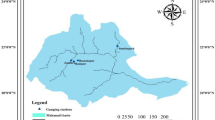Abstract
Flood is common phenomena worldwide since time immemorial. Recently the change in climatic parameters has drastically affected the pattern and magnitude of flood. India being one of the tropical country face flood and drought situations every year, therefore it needs accurate assessment and forecast of flood for proper management of natural resources.
An attempt has been made through the present study which consists frequency analysis on maximum daily discharge data in Betwa river at Basoda, Mohana and Shahijina gauging stations in Madhya Pradesh state using Gumbel’s Extreme value distribution and Log Pearson Type-3 distribution for 20 years period (1993-2012).
The result shows that Log Pearson Type-3 distribution is better suited for Betwa basin. The results can be used by civil engineers for deciding the dimensions of hydraulic structures such as spillways, dams, bridges etc. Floods are forecasted for the different return periods for Betwa river.
Similar content being viewed by others
References
Abdul-Karim, M.D. and Chowdhury, J.U. (1995) A comparison of four distributions used in flood frequency analysis in Bangladesh. Hydrol. Sci. Jour., v.40(1), pp.55–66.
Ahlawat Ritu (2014) Use of GIS in optimal spatial network of hydrological data in Betwa river catchment. Internat. Jour. Geomatics and Geosciences, v.4, pp.645–66.
Alila, Y. and Mtiraoui, A. (2002) Implications of heterogeneous flood-frequency distributions on traditional stream-discharge prediction techniques. Hydrol. Process., v.16, pp.1065–1084. DOI: 10.1002/hyp.346.
Blazkovaa, S. and Bevenb, K. (1997) Flood frequency prediction for data limited catchments in the Czech Republic using a stochastic rainfall model and TOPMODEL. Jour. Hydrol., v.195, pp.256–278.
Burn, D.H. (1990) Evaluation of regional flood frequency analysis with a region of influence approach. Water Resources Res., v.26(10), pp.2257–2265.
Chow, V.T., Maidment, D.R., Mays, L.W. (1988) Applied Hydrology. McGraw Hill Book Company, Singapore.
Cunnane, C. (1973) A particular comparison of annual maximum and partial duration series methods of flood frequency prediction. Jour. Hydrol., v.18, v.257-271.
Gumbel E.J. (1958) Statistics of Extremes. Columbia University Press, New York.
Gumbel E. J. (1960) Multivariate extreme distributions. Bull. Internat. Statist. Instit., v.39(2), pp.471–475.
Hann, C.T. (1977) Statistical Methods in Hydrology. Iowa State University Press, Iowa.
Izinyon, O.C. and Igbinoba, E. (2011) Flood Frequency Analysis of Ikpoba River Catchment at Benin City using Log Pearson Type III Distribution. JETEAS, v.2(1), pp.50–55.
Mujere, N. (2011) Flood frequency analysis using the Gumbel distribution. Internat. Jour. Computer Sci. Engg., v.3, pp.2774–2778.
Narmada basin, Hydrology and Water Resources Information System (HWRISH), Narmada Basin, http://www.nih.ernet.in/rbis/basin%20maps/narmada_about.htm.
NIST/SEMATECH (2012) “e-handbook of statistical methods” http://itl.nist.gov/div898/handbook.
NCA (2005): “Narmada control authority (NCA)” http://nca.gov.in/nb_geogr.htm.
NVDA (1985) “Narmada Valley Development Authority, Government of Madhya Pradesh, Narmada Basin, Narmada Water Dispute” Nvda.nic.in. 1985-07-16.
Pegram, G. and Parak, M. (2004) A Review of the Regional Maximum Flood and Rational Formula using Geomorphologic Information on Observed Floods. Water SA, v.30(3), pp.377–388.
Reddy, J.A. (2006) A textbook on hydrology. Laxmi Publications, New Delhi.
Reis, D.S. and Stedinger, J.R. (2005) Bayesian MCMC flood frequency analysis with historical information. Jour. Hydrol., v.313, pp.97–116.
Shaw, E.M. (1983) Hydrology in Practice. Van Nostrand Reinhold, UK.
Shobharam Ahirwar and Shukla, J.P. (2015) Upper betwa river watershed management and development plan using remote sensing and GIS. IJESRT, v.277-9655, pp.484–491.
Stedinger J.R. and Vogel R.M. (1993) Frequency analysis of extreme events. Handbook of Hydrology, chapter 18, McGraw-Hill, New York.
Subramanya, K. (2010) Engineering Hydrology. McGraw Hill Book Company, Singapore, pp.255–265.
Tumbere, M. J. (2000) Mitigating Flood in South Africa. Paper presented at the 1st WARSFA/water Net Symposium: sustainable use of water Resources, 1–2 November, Maputo.
Todorovic, P. (1978) Stochastic models of floods. Water Resource Res., v.14(2), pp.345–356.
Watt, W.E. et al. (1989) Hydrology of Floods in Canada. A Guide to Planning and Design, National Research Council of Canada. Jour. Hydrol., v.131, pp.387–391.
Yue S., Ouarda T., et al. (1999) The Gumbel Mixed Model for Flood Frequency Analysis. Jour. Hydrol., v.226, pp.88–100.
Author information
Authors and Affiliations
Corresponding author
Rights and permissions
About this article
Cite this article
Pandey, H.K., Dwivedi, S. & Kumar, K. Flood Frequency Analysis of Betwa River, Madhya Pradesh India. J Geol Soc India 92, 286–290 (2018). https://doi.org/10.1007/s12594-018-1007-6
Received:
Accepted:
Published:
Issue Date:
DOI: https://doi.org/10.1007/s12594-018-1007-6




